No products in the cart.
Table of Contents
Did you know that Begonia plants help clean the air by filtering out benzene and other hazardous substances? They cleanse the air you breathe and remove airborne contaminants inside your home. So there’s no doubt that this beauty is the perfect indoor plant for you!
It has pointy peltate leaves with dark red dots and a dark red thin border around the margins. The plant’s distinctive shape, hues, and speckled pattern make it look divine. This beauty also produces its own blossoms! The tiny unique flowers bloom at any time of year, adding to the plant’s charm.
Want to have an air-purifying houseplant for your home? Don’t worry, Plantly always had your back! Read more below to find it out.
Begonia Amphioxus Plant Care Basics
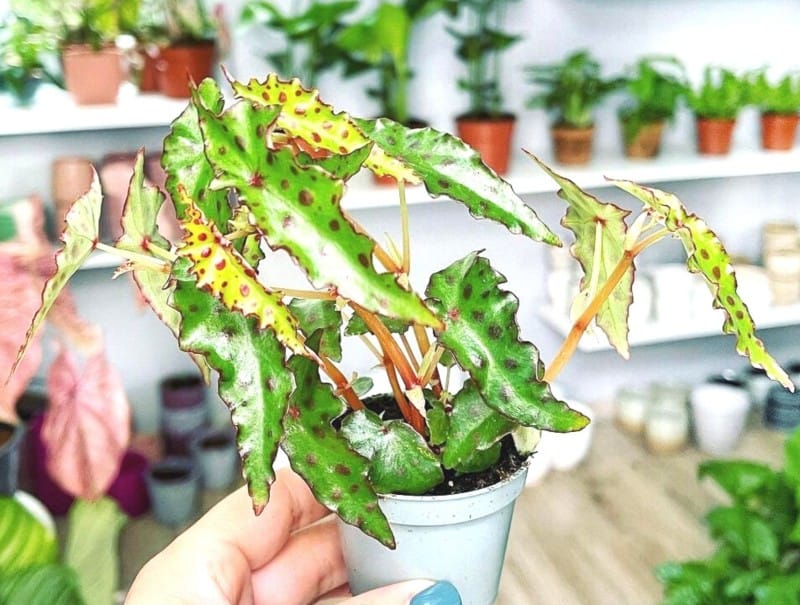
Don’t skip this part! Here’s a glance at the basic things you need to know about the care and maintenance of this plant. We’ve provided them in the following table.
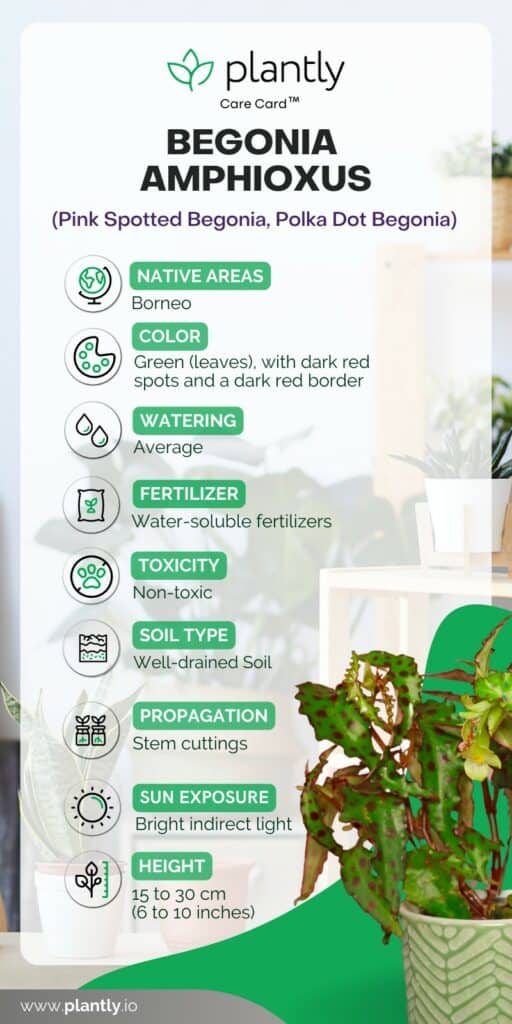
A getting-to-know each other a little was not that hard, wasn’t it? For the most awaited part, we will now give you tips, do’s, and don’ts in caring for this type of Begonia. So don’t just leave yet because there’s more below.
Preparing the Potting Mix
The plant Begonia amphioxus responds well to well-drained, rich soil. You can either purchase a ready-made loam or peat-based mix or DIY! Mix sphagnum moss with sand, grit, bark, or perlite to ensure good drainage and air circulation.
This plant will also benefit from a high-quality peat mix for houseplants. The soil or substrate acidity should be between 6.1 and 7.5. (mildly acidic to neutral).
Pro tip: If you don’t have anything mentioned above, you can add limestone chips, oyster shells, or eggshells to the soil to strengthen the structure of the substrate. These things basically have the same function so you could use them as alternatives.
Watering Regimen
Amphioxus requires an average to a substantial amount of water. It is recommended that you water it every other day during the summer and once a week during the winter. Make sure the soil is somewhat dry between waterings.
Remember that the water should be warm, not cold or hot since this could shock and stress the begonia.
Pro tip: It is necessary to allow the leaves to completely dry between waterings to avoid leaf rot and fungus. It’s best to water in the morning so the foliage would have enough time to dry.
Setting the best light condition
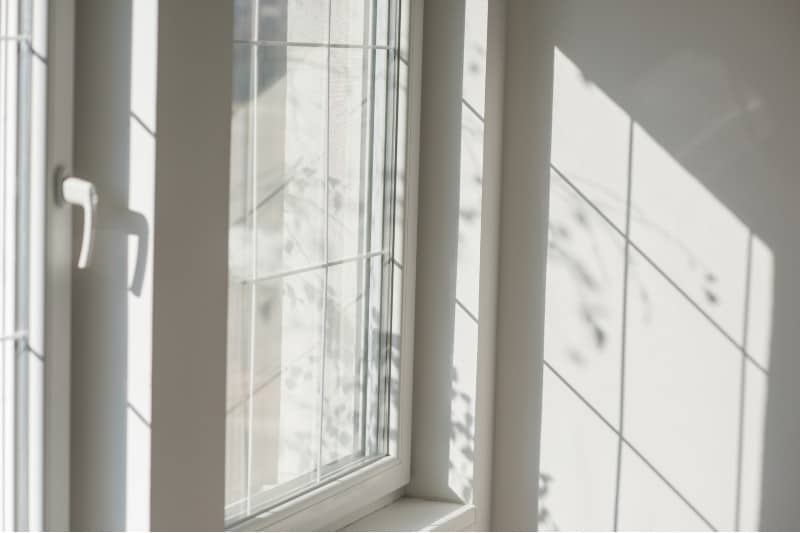
The plant prefers a range of bright indirect light to partial sun. You may put it in a very sunny location outdoor in a shaded area. But make sure you don’t expose the plant to direct sunlight, as this will cause leaf scorching.
If placed indoors, positions near the North or East windows, with direct moderate morning sun, are ideal. Shading Begonia amphioxus is essential in the heat of summer and spring, especially if you reside in a northern climate.
The plant requires little or no shading in the fall and winter. Adding in artificial light will also help augment the lacking sunshine during low light conditions.
Pro tip: Begonia amphioxus grows slowly, stagnantly, and gradually withers if not given appropriate lighting.
Watching out for the temperature

All year-round, the ideal temperature is between 50 and 85 degrees Fahrenheit (10 and 29. 4 degrees Celsius). It demands a warm habitat because it is a tropical species. If you expose the Begonia to temperatures below 50 degrees Fahrenheit (10 degrees Celsius) for even a brief period, it will lose all of its leaves.
So, be extra mindful of the temperature needs of this beauty.
Pro tip: If you want to change the temperature, do it gradually. This will allow the plant to acclimate to the new environment. Otherwise, you’re going to stress the plant causing it to shed those precious leaves.
Maintaining proper humidity
Begonia amphioxus needs a high amount of humidity. And that humidity requirement is substantially greater than in our homes! This is one of the reasons why this plant enjoys sealed habitats like terrariums.
But don’t just lose hope yet. As we always say, there’s an answer to every problem! You can also mist your plant, particularly during hot and dry days. However, Begonias are susceptible to fungal infections and are sensitive to water retention on the leaves.
So always mist in the morning. In that case, the droplets have enough time to dissipate during the day and do not linger too long on the leaves. You can also add a pebble-water tray under your plant container to regulate humidity if your home environment is too dry. Furthermore, a humidifier can do the same function.
Be cautious not to overwater your plant for long periods.
Applying fertilizer
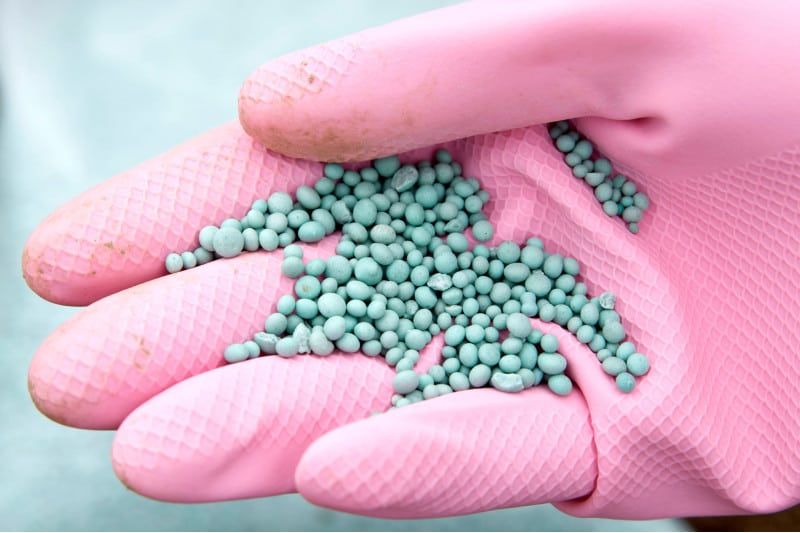
In the summer, this polka dot begonia requires monthly fertilization. However, in the winter, once every two to three months is recommended. For houseplants, you can use water-soluble fertilizers that you can apply once or twice a month when watering the plant.
Always dilute the fertilizer to a quarter of the recommended dose because high chemical concentrations might injure or burn the roots.
We advise that you don’t overfertilize your amphioxus plant. Remember that too much is dangerous. Overfertilization could instantly kill any plant because of the high concentration of salts that eventually damage the roots.
Propagating using the stems
Amphioxus is an exotic plant that you’d surely want to replicate. But there’s absolutely no need to buy another. Propagating the plant is the way.

This beauty can be easily propagated through stem cuttings. Here’s how to do it.
- Cut a 5 to 6-cm long stalk from a fully developed adult plant with a sharp knife; the stalk must be pointed on both ends.
- Remove the leaves from the lower section of the stem cutting and immerse the base in growth hormone.
- Then, plant it in damp soil or sphagnum moss.
- Make sure the seedlings are at least 3 inches deep when planting.
- Place the plant container in a warm, humid environment with some bright but indirect light.
- Make sure you know how to cut the upper and bottom stems. As a result, the propagation will fail if you plant the stem in the wrong direction and don’t understand its growth behavior.
- After three to four weeks, roots will begin to sprout.
Pro tip: Stem cuttings can be propagated easily by placing them in damp sphagnum moss and keeping them hydrated in medium to high indirect light.
Growing Zones
USDA zones 3 through 11 are suitable for growing the amphioxus plant. In general, they are frost-sensitive. They are only hardy in zones 8 to 11 in the winter.
Potting to a new container
Begonia amphioxus should be planted in a container that drains well and is just large enough to accommodate the plant’s size. Standard nursery pots of the right size will do the trick. When the roots of Begonia amphioxus have completely filled the container, it is time to repot.
Use a container that is slightly larger than the last one, but not excessively so. Fresh soil should be used to replace the old one.
Pruning the foliage
They don’t need to be pruned to keep growing, but they will benefit from ‘grooming’ to hold their shape. Once a year, clip or chop off any dead leaves or branches on your Begonia amphioxus. For a healthy appearance, this is generally adequate.
Pruning diseased parts is another story. You must do this with extra caution. Carefully dispose of the infected parts so they won’t spread to other houseplants.
Other Begonia species
We just want to spoil you that many similar plants like this beauty can be added to your collection! Yes. And here are some of those beauties:
Begonia tamaya
Begonia albopicta’ Tamaya’ is a bit shrub-like plant with speckled leaves. It is a tree-like trunk and has lovely flowers (white or pink) that blossom from below.
‘Charm’ Begonia
The ‘Charm’ kind of Begonia features vibrant yellow splotches on brilliant green foliage, giving it a psychedelic impression.
Begonia ‘Lucerna’
‘Corallina de Lucerna’ was its original name. This outdoor plant produces a lot of flowers and grows quickly. The leaves are olive green on top and crimson on the underside, with tiny silver dots.
Begonia amphioxus Diseases & Pests
If you’re growing your plant in a large glasshouse with many other plants, bugs are more likely to find it. However, if you deal with your Begonia amphioxus problem quickly and effectively, you should be able to eliminate it. That is why Plantly will help you get rid of those problems.
Pests
Thrips are tiny insects that feed on the sap of plants and reproduce swiftly. If you see thrips on the plant, you might try rinsing them off with a water spray. However, some of them survive the treatment and continue to degrade the plant.
Use natural insecticides like neem oil treatments in this scenario.
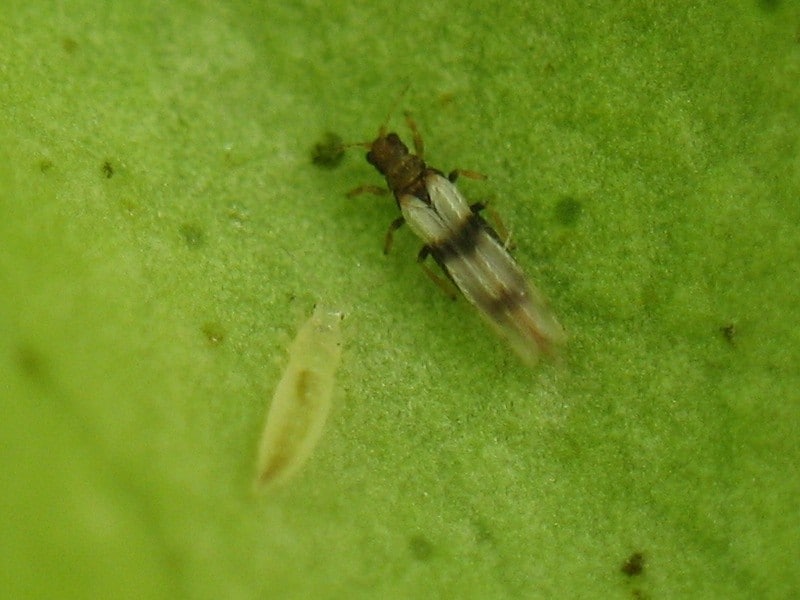
Mealybugs can also infect your plant. Using a cotton swab soaked in rubbing alcohol, wipe the afflicted areas of the plant. The plant can also be dipped in a solution of soapy water and rubbing alcohol. Continue with this treatment for as long as you need it.
Large infestations can be treated with horticultural oils and insecticidal sprays.

Diseases
White patches appear on the leaves, stems, and buds of plants caused by powdery mildew. High humidity, wet leaves, cool temps, and healthy plants are their favorites. Avoid watering from above and provide adequate air circulation and ventilation. If the problem worsens, fungicides can assist.
Bacterial leaf spot is more likely to appear in the summer when humidity and temperature are highest. Isolate the affected plant, remove and destroy infected sections, and spray the plant with a bacterial leaf spot treatment if the situation is serious.
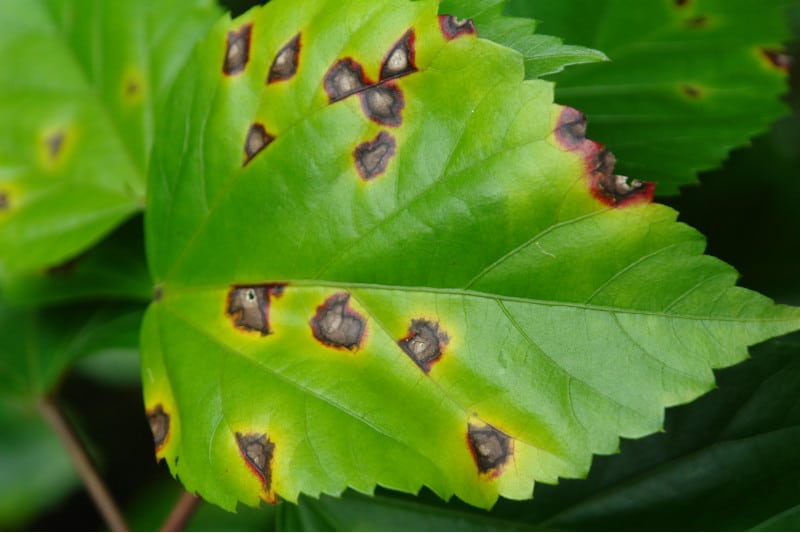
When watering, avoid splashing water on the foliage.
Frequently Asked Questions
Yes, you can propagate your genus begonia by leaf propagation. A single leaf can generate many baby polka dot begonia, which you can use to expand your begonias collection. This method works for all begonias, but it’s perfect for foliage plants.
You can pinch back your Begonia if it’s getting lanky or if you want to shape it a little. Pinching and trimming your Begonia will aid in the development of a fuller, bushier plant. Wherever you prune, new stems will slightly sprout. Late autumn is the optimum time to prune to preserve height if your plants grow too tall. Your amphioxus plants will then finished flowering and will begin to slow down in the winter.
Begonia amphioxus needs bright yet indirect light to keep blooming. It’s good to have some early light source from the sun for an hour or two. However, be careful with the fragile leaves of the Begonia amphioxus because they are readily burned. Also, the plant needs quality fertilizer to add to its full bloom, both its leaves and flowers. A peat mix with limestone or eggshells is a good option for good soil.
Plantly is very open to taking your orders, reservations, and questions! Plus, we offer faster transactions online. Connect with us today to get hold of this beauty!
Whether you want to buy, sell or simply reach out to other plant enthusiasts, Plantly is the right place to be!


